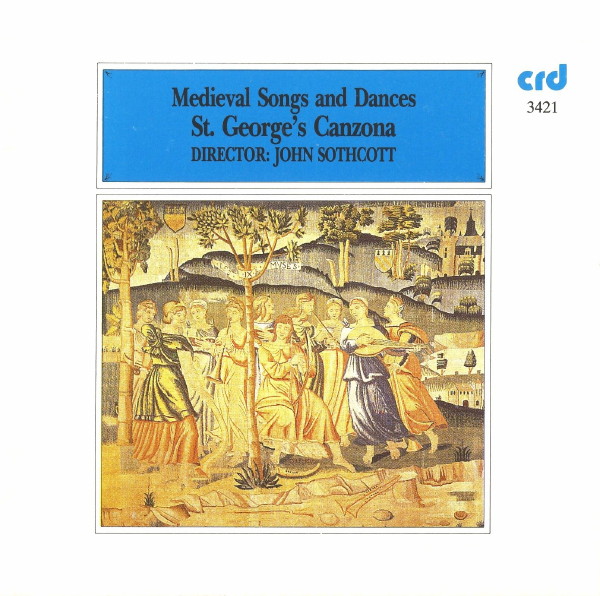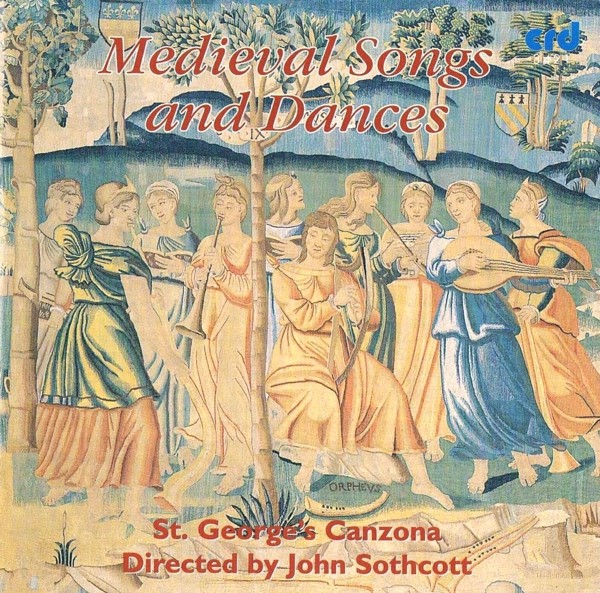Medieval Songs and Dances
St. Georges's Canzona

medieval.org
crd 3421
1985
1. Lamento di Tristano [3:46]
anon. Italian 14th c. — viele
2. Quant voi en la fin d'este [4:19]
Perrin d'AGINCOURT (trouvère) active mid 13th c. — counter-tenor, viele, citole,
recorder MO
3. L'autrier m'iere levaz [2:59]
anon. (troubadour) French pastourelle 12th c. — baritone, viele,
citole, recorder MO
4. Estampie real [1:58]
anon. French 13th c. — harp
5. Edi beo thu hevene quene [2:14]
anon. English late 13th c. — soprano, counter-tenor, viele, citole, 2
recorders
6. Eyns ne soy ke pleynte fu [6:04]
anon. English early 13th c. — counter-tenor, viele, harp
7. Estampie real [2:37]
anon. French 13th c. — viele, citole, 2 recorders, nakers
8. Estampie real [2:16]
anon. French 13th c. — viele, citole, recorder MO, nakers
9. Se ome fezer [2:38]
Cantigas de Santa Maria, Spanish 13th c.
CSM 207
soprano, counter-tenor, tenor, baritone, viele, citole, pipe &
tabor, bagpipe
10. Nas mentes senpre tẽer [3:57]
Cantigas de Santa Maria, Spanish 13th c.
CSM 29
soprano, mandola, citole, flute
11. Estampie real [2:10]
anon. French 13th c. — mandola, citole, recorder MO, rotte
12. Como poden per sas culpas [2:51]
Cantigas de Santa Maria, Spanish 13th c.
CSM 166
tenor, baritone, viele, citole, recorder MO, bagpipe
13. Maravillosos et piadosos [4:10]
Cantigas de Santa Maria, Spanish 13th c.
CSM 139
soprano, counter-tenor, tenor, baritone, mandola, citole, 2
recorders
14. Tre fontane [7:58]
anon. Italian 14th c. — viele, citola, tabor
all arrangements ©John Sothcott / St. George's Canzona
Produced by Simon Lawman
Balance Engineer: Bob Auger
Production liaison: John Grubb
Recorded at the Church of St. James, Clerkenwell, London, EC1
Front cover reproduction: 'Orpheus and the Muses', tapestry
woven in wool and silk. French; 16th Century.
Reproduced by courtesy of the Board of Trustees of the Victoria and Albert Museum, London.
℗ 1985 CRD RECORDS LTD.
© 1985 CRD RECORDS LTD.
St. Georges's Canzona
John Sothcott
Ray Attfield – baritone, nakers, tabor
Cecil Elliston Ball – tenor
John Grubb – citoles, harp
Derek Harrison – counter-tenor
Rosemary Harrison – soprano
Michael Oxenham – recorders, pipe and tabor
Michael Sargeant – bagpipe, flute, rotte, recorders
John Sothcott – vieles, mandola
St.
George's Canzona was formed as a recorder trio in 1966 but it quickly
expanded during the following year to become a small ensemble of voices
and instruments, able to perform a wide variety of music from the middle
ages and the Renaissance, although their repertoire contains far more
popular secular, than liturgical music.
Although he comes from a
classical background, the musical director, John Sothcott also has an
interest in folk music and this influenced the group's gradual evolution
into a balanced consort which bases its performance both on the
practices of the minstrels and jongleurs as far as they are known, and
on such traditional styles as have apparently survived from early times
in remote parts of Europe.
As well as playing all over England,
St. George's Canzona has made or participated in, some dozen and a half
records. A regular Winter/ Spring series of concerts at the Playhouse,
in Harlow, Essex, has given the group an opportunity to develop a large
number of new programmes. These have included historical dancing (in
collaboration with the Renaissance Dance Company of London) and
experiments with spoken narrative taken from historical sources.
The
problem of obtaining authentic period instruments has been solved
partly by commissioning from specialist makers, but many of the
instruments which are based on pictures and sculptures have been made by
John Sothcott.
The group normally consists of eight performers
but this number can be augmented for specific programmes. Its repertoire
covers music from about 1100 AD to 1650 AD and includes some folk and
traditional music from all over Europe.
The Musical Director, John Sothcott,
trained as a violinist and originally came into the field of Early
Music as a recorder player who specialised in highly embellished
versions of eighteenth century chamber music. Later he became interested
in earlier music and was one of the founder members of Musica
Reservata. He has broadcast many times as a recorder soloist and as a
member of such groups as Bruno Turner's Pro Musica Sacra, The Deller
Consort, Cantores in Ecclesia and the English Chamber Orchestra. John
Sothcott now devotes most of his time to the making and playing of
medieval bowed and plucked instruments.
Ray Attfield
originally joined the group as a percussionist but now he also performs
as a singer and Hurdy Gurdy player. He began as a folk singer and is now
very interested in the vocal and instrumental styles of traditional
musicians throughout the world.
Cecil Elliston Ball is an
experienced choral singer who has become increasingly interested in the
challenge of singing medieval and renaissance music.
John Grubb,
originally a guitarist, now fully occupies himself with medieval and
renaissance plucked instruments including, citole, gittern, lute and
harp. He also performs with other groups including Noise of Minstrels and Silva Lirica.
Derek Harrison
is an outstanding counter tenor and a versatile musician who plays both
stringed and keyboard instruments. He is choir master to St. George's
Canzona and the conductor of the Hertford Choral Society. He was a
member of the Clerkes of Oxenford and a chorister at Salisbury Cathedral.
Rosemary Harrison studied music at Oxford and has wide experience of singing in such choirs as the Clerkes of Oxenford, also as a soloist in music of all periods.
Michael Oxenham
is a experienced orchestral clarinettist, who now specialises in
playing medieval and renaissance wind instruments, including cornett,
recorder, crumhorn, rackett, shawm, kortholt and curtal. He plays pipe
and tabor for the Mayflower Morrismen in Billericay and drums with a Ceilaidh band. He also appeared with Musica Reservata and Cantores in Ecclesia in BBC broadcasts and recordings.
Michael Sargeant plays bagpipes, woodwind and percussion. He performs regularly with St. George's Canzona, Noise of Minstrels and Silva Lirica. In addition to recitals and recording, Michael is a licenced Covent Garden busker.

Performing music from the popular
repertory of the Middle Ages poses a number of problems. Scholars can
now decipher much of the notation, but, in many cases the satisfactory
realisation of the music has to rely on knowledgeable conjecture,
especially in respect of the rythmic values of the notes. Decorations,
embellishments and additional parts have to be inserted and, above all,
a convincing vocal and instrumental stylistic framework has to be
evolved.
Instruments often impose their own character on the phrasing and
articulation by virtue of the playing techniques involved, but the very
flexibility of the human voice and its ready adaption to the standards
of every culture and age makes the production of an "authentic" vocal
style for medieval music particularly difficult. Even today with
worldwide communications, different places and cultures have very
different ideas of what constitutes "beautiful" singing.
In order to tackle this problem, St. George's Canzona have taken a
number of factors into account. These include the written descriptions
and treatises of the Middle Ages, the character and compass of the
music itself, ethnic survivals - especially where music still plays a
similar part in peoples lives as it did in ancient times, the
characteristic phrasing and timbre of the instruments with which the
voices have to combine and, most important the performing qualities and
temperament of the singers themselves.
The music on this record is taken from sources dating from the 12th to
the 14th centuries and the origin of most of the items appears to lie
in the popular or traditional music of the time. The Troubadours,
Trouveres and their English and Spanish equivalents often used popular
tunes as settings of their verses and the Minstrel fraternity that were
frequently employed by them; used and may at times have invented much
of the popular repertory.
The Troubadours and Trouveres were often, but not always, members of
the nobility and their verses reflect various aspects of courtly life,
from the stylised expressions of chivalric love to the frankly erotic.
Musical instruments are often mentioned in their songs, particularly
the viele (fiddle) and the citole. These instruments had strings tuned
concordantly in a mixture of fourths and fifths to facilitate the use
of the open, unstopped, strings as drones.
Many of these types of instrument are pictured in the M.S.S. of the
collection known as the Cantigas de Santa Maria which was put
together by King Alfonso The Wise in order, so it is said, to preserve
the ancient Galician language. The cantigas are all in praise of the
Blessed Virgin Mary and relate various episodes in her life.
The cantiga "Se ome fezer" is set to a melody of popular type,
with a definite Iberian flavour; "Maravillosos" on the other
hand seems to be derived from liturgical plainchant origins.
Eyns ne soy ke pleynte fu appears in two versions in English and
in French; this recording uses the English version. The prisoner
laments his imprisonment "for the sins of others".
A Parisian M.S.S. of the 13th Century contains a number of Estampies
Real or Royal Estampies. This basic instrumental form consists of
á sequence of melodic phrases each with first and second time
sections known as puncti. The "royal" of the title may refer to
connections with royal or champion Minstrels chosen at their
gatherings, usually held during Lent.
The Italian Istampitta, Tre fontane and Lamento di
Tristano are from a collection in the British Museum dating from
the 14th Century, which appears to be the attempts of a scribe to write
down what the Minstrels played. These pieces have a flavour of the
Orient and this, together with the virtuoso nature of the passage-work,
may reflect the influence of the Moors and other arrivals from the Near
East.
Neither of these manuscripts give any indications of instrumentation
although the compass required and general tessitura, particularly of
the Italian pieces, suggests strongly that the Viele must have played a
prominent part. We have combined this with its sister instrument the
Citole and where appropriate other self-accompanying instruments such
as the Bagpipe, Pipe and Tabor and Harp.
© John Sothcott, 1985

